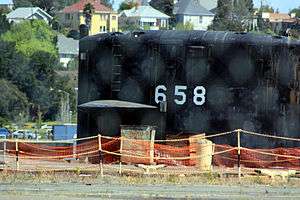USS Mariano G. Vallejo (SSBN-658)
USS Mariano G. Vallejo (SSBN-658), was a Benjamin Franklin-class fleet ballistic missile submarine, was named for Mariano Guadalupe Vallejo (1807–1890), a key proponent of California statehood. The boat's service extended from 1966 until 1995.
 USS Mariano G. Vallejo (SSBN-658) off Mare Island sometime in December 1966. | |
| History | |
|---|---|
| Namesake: | Mariano Guadalupe Vallejo (1807-1890), a proponent of California statehood |
| Ordered: | 8 August 1963 |
| Builder: | Mare Island Naval Shipyard, Vallejo, California |
| Laid down: | 7 July 1964 |
| Launched: | 23 October 1965 |
| Sponsored by: | Miss Patricia O. V. McGettigan |
| Commissioned: | 16 December 1966 |
| Decommissioned: | 9 March 1995 |
| Stricken: | 9 March 1995 |
| Fate: | Scrapping via Ship and Submarine Recycling Program begun 1 October 1994, completed 22 December 1995 |
| Status: | Recycled |
| General characteristics | |
| Class and type: | Benjamin Franklin-class fleet ballistic missile submarine |
| Displacement: |
|
| Length: | 425 ft (130 m) |
| Beam: | 33 ft (10 m) |
| Draft: | 31 ft (9.4 m) |
| Installed power: | 15,000 shp (11,185 kW) |
| Propulsion: | One S5W pressurized-water nuclear reactor, two geared steam turbines, one shaft |
| Speed: | Over 20 knots (37 km/h; 23 mph) |
| Test depth: | 1,300 feet (400 m) |
| Complement: | Two crews (Blue Crew and Gold Crew) of 120 men each |
| Armament: |
|
Construction and commissioning
The contract to build Mariano G. Vallejo was awarded to Mare Island Naval Shipyard at Vallejo, California, on 8 August 1963 and her keel was laid down there on 7 July 1964. She was launched on 23 October 1965, sponsored by Miss Patricia O. V. McGettigan, and commissioned on 16 December 1966, with Commander Douglas B. Guthe commanding the Blue Crew and Commander John K. Nunneley commanding the Gold Crew.
Service history
Mariano G. Vallejo conducted shakedown and training exercises along the United States West Coast, in the Caribbean Sea, and off the coast of Florida. Transiting the Panama Canal for the second time on 21 March 1967, she headed for her assigned home port, Pearl Harbor, Hawaii. Arriving there on 10 April 1967, she continued training exercises and sound trials, then returned briefly to Mare Island Naval Shipyard. From there she sailed back to Pearl Harbor, becoming, as of 1 August 1967, a fully operational unit of Submarine Squadron 15, ready to conduct strategic deterrent patrols.
Mariano G. Vallejo was the last to patrol, last to off-load her missiles and the last to arrive in Washington making her the last of the "Forty-one for Freedom." On 2 August 1994, the submarine left Charleston for the last time. She arrived at the Panama Canal on 10 August and during the voyage to San Diego transited 20 nautical miles (37 km) from the epicenter of a 7.2 earthquake. In port at the Mare Island shipyard the crew hosted over three thousand tours of the ship in eleven days.
Decommissioning and disposal
Mariano G. Vallejo was both decommissioned and stricken from the Naval Vessel Register on 9 March 1995. Her scrapping via the U.S. Navy's Nuclear-Powered Ship and Submarine Recycling Program at Bremerton, Washington, began on 1 October 1994 and was completed on 22 December 1995.
Commemoration
Mariano G. Vallejo's sail was preserved, and has been on the waterfront at Mare Island since 1995. It is slated to become part of a memorial there. In addition to the preservation of the sail, the control room of Mariano G. Vallejo is being reconstructed within the Mare Island Museum including a fully operational periscope from Mariano G. Vallejo.
A Google Street View of the boat's sail is located here.

References
- This article incorporates text from the public domain Dictionary of American Naval Fighting Ships. The entry can be found here.
- This article includes information collected from the Naval Vessel Register, which, as a U.S. government publication, is in the public domain. The entry can be found here.
- Photo gallery of USS Mariano G. Vallejo (SSBN-658) at NavSource Naval History – Keel Laying
- Photo gallery of USS Mariano G. Vallejo (SSBN-658) at NavSource Naval History – Construction & Launching
- Photo gallery of USS Mariano G. Vallejo (SSBN-658) at NavSource Naval History – Sea Trials - Commissioning
- Photo gallery of USS Mariano G. Vallejo (SSBN-658) at NavSource Naval History – Active Service - Decommissioning
- "hazegray.org: USS Mariano G. Vallejo" (txt). Retrieved 26 September 2011.